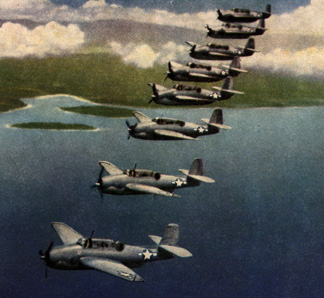|
U.S. Naval Aviation In the South Pacific during WW II Featuring the Lexington Aircraft Carrier The Battle of the Marianas — June 1944 Chapter 3 Page 1 of 7 Pages |
||||||||||||||||||||||||
|
Long Beach Rotary Club Evening Program, October 2, 1991 The things I will be talking about today occurred almost 50 years ago. To you younger members please treat my presentation as a short statement regarding a little bit of personal history. For those of you who are near my age, perhaps what I say will trigger memories of your own activities during World War II. I had decided in 1941 that I wanted to become a naval aviator. At that time the two basic requirements in addition to good physical health, were that the applicant had to have completed two years of college and be 20 years or more of age. In June, 1941 I had met the educational requirement and on December 7, 1941 I became 20 years of age. |
||||||||||||||||||||||||
 |
||||||||||||||||||||||||
|
November 1998 |
||||||||||||||||||||||||
 |
||||||||||||||||||||||||
|
I reported to the US Navy "E" (elimination) Base at the Long Beach airport on December 8, 1941 and was inducted into the US Navy Reserve as a Seaman 2c. I remained in Long Beach until about mid March, 1942. I was then designated a naval aviation cadet and ordered to Corpus Christi, Texas for flight training. Flight training continued until September 25, 1942 at which time I was commissioned an Ensign and given the coveted "Wings of Gold." I was then ordered to Opaloka Naval Air Station near Miami, Florida for operational training and further assignment to a fleet squadron and air group. One month later I was ordered to proceed to NAS Norfolk, VA for carrier qualification and then on to NAS Quonsett Point, RI where I would join Air group 16 as a member of the torpedo squadron.
Upon arrival at Quonsett Point I learned that Air group 16 was destined to go aboard the new carrier CV-16 which was then in the final phases of construction at the Boston Shipyards. This new carrier was to be given the name USS Lexington and replaced a carrier by the same name that had been sunk on May 8, 1942 in the Battle of the Coral Sea. |
||||||||||||||||||||||||
|
Below: Tom Bronn (L) with two friends celebrate graduation from flying training |
||||||||||||||||||||||||
 |
||||||||||||||||||||||||
 |
||||||||||||||||||||||||
|
|
||||||||||||||||||||||||
| An air group in those days consisted of three squadrons made up of fighters, dive bombers and torpedo bombers. There were approximately twenty pilots each in the dive bomber and torpedo bomber squadrons, and sixty pilots in the fighter squadron. In air group 16 the fighter pilots flew the new Grumman F6F Hellcat; the dive bomber pilots flew the Douglas SBD Dauntless and the torpedo bombers flew the new Grumman TBF Avenger. I had not seen the Avenger before arriving at the squadron so I needed to get acquainted at once. |
||||||||||||||||||||||||
 |
||||||||||||||||||||||||
 |
 |
|||||||||||||||||||||||
|
bomber called the “Avenger.” Ctsy. Life Inc. |
“Dauntless” dive bomber. Ctsy. Life Inc. |
“Hellcat” carrier fighter. Ctsy. Life Inc. |
||||||||||||||||||||||
| It was at the squadron level that the real training for combat began. In addition to the pilot, the Avenger carried a two man crew consisting of a turret gunner and a radio/radar man. My crewmen were assigned to me; E. P. Linson, radio/radar man and Michael Banazak, gunner. We got to know each other and to respect each other. Each of us was learning a job that was new to us and it became apparent that each of us had to depend on the other to be an effective team. In addition to squadron tactics there were overall air group tactics that had to be learned and practiced again and again and again. |
||||||||||||||||||||||||
 |
||||||||||||||||||||||||
|
formation flying training Ctsy. Life Inc. |
||||||||||||||||||||||||
|
Below: Tom Bronn’s Avenger crew |
||||||||||||||||||||||||
 |
||||||||||||||||||||||||
|
Chapter 3— End of Page 1 of 7 Pages — Go to Page 2 Page —1 — 2 — 3 — 4 — 5 — 6 — 7 Or This Story’s Cover Page — Editor’s Introduction — Table of Contents Fred Gwynn’s “Torpedo 16” — Chapter — 1 — 2 — 3 — 4 Or Home - Contact Us - Cold War Hist. - 91st SRS Hist. - Stardust 40 Mission Story |
||||||||||||||||||||||||